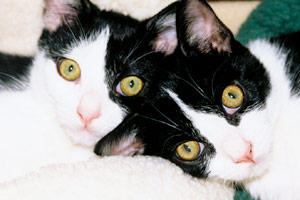A tale of two brothers
 To a large extent, success within No More Homeless Pets depends upon a business-minded, measurement approach. But, at heart, it’s still all about single acts of kindness, one at a time.
To a large extent, success within No More Homeless Pets depends upon a business-minded, measurement approach. But, at heart, it’s still all about single acts of kindness, one at a time.
There are always two conversations going on within the animal welfare movement: One is about the big picture — strategy, numbers, trends, policy and programs. The other is about the little picture — this dog or that cat, rat, parrot, ferret, bunny or whatever.
Here’s a story right from the heart of the little picture. It’s about Milo and Simon (pictured above), two kitten brothers who could have popped right out of a cartoon. They were black and white with perpetually surprised eyes and all the mischief of a pair of raccoons in an old Walt Disney nature movie.
For several months, Milo and Simon kept themselves, and the rest of us, hugely entertained, oblivious to the curse that hung over their heads — they came to Best Friends with feline leukemia, a virus that takes its worst toll on kittens.
In the “big picture” approach to animal rescue, these two, whose chances of surviving their first birthday were slim, would have been put down immediately to make room for healthy cats who might otherwise die for lack of a home. It would have been quite reasonable and understandable considering the bigger picture. But, the person who took them from the person who rescued them as part of a litter of feral kittens wasn’t looking at the bigger picture. She was looking at two saucer-eyed darlings, with no signs of illness and with energy to burn and charisma to spare. And by the time they reached the age that a valid blood test could be performed, it was way too late for them to become mere statistics in the big picture.
Their future was a crapshoot. Sometimes, kittens with fe-leuk go on to blossom and live reasonably long lives. More often, they just fade. The immediate problem with Milo and Simon, however, was to find a place for them to explore their uncertain future without the risk of infecting healthy cats or being exposed themselves to any of the routine “kittenhood” illnesses that could wreak havoc with their weakened immune system.
Judah Battista, then manager of the Best Friends clinic, decided to give Milo and Simon a home, knowing full well that anything could happen. And for a while it did! The little monsters were anywhere and everywhere, especially at 5 a.m. when they would tear around his house like a pair of squirrels chasing each other around the trunk of a tree. When interrupted, their heads would pop up in unison with that “who me?” look of surprise. It’s hard to imagine two more lovable and cute young cats.
And then it happened. First, Milo began to tire of play, and would sleep just a bit more than normal. Then he grew weaker and weaker, despite every traditional and alternative immune-boosting and blood-building therapy. Eventually, it was time to spare him the suffering of a life that no longer had any quality.
Soon after, Simon’s life took the same course.
So, why am I telling you this bittersweet tale? It’s because the small picture of individual lives, with all their joy and sadness, has a way of getting in the way for people whose main concern is the “big picture” — whether in the humane world or in the world of human affairs just generally.
I’ve worked with a lot of big picture humane organizations, and they often have a way of divorcing themselves from the messy and unpleasant details of the fate of individual animals and the “crazy animal people” who advocate for them. Whenever they do this, they leave something of themselves behind: their heart.
That doesn’t mean for a moment that they don’t care. Quite the opposite. They have often been torn apart by the emotions — their own and those of the grassroots animal people who come to them for help — of all those individual small pictures.
The solution that big picture organizations try to impose on the humane movement is to lay out straight lines, clear strategies and firm policies. But for the grassroots groups, and the animals themselves, every homeless pet is the next in a million exception to any rule one might wish to impose.
And the story of Milo and Simon is just another of those exceptions: a story of the heart and soul, and a story of simple acts of kindness from the time of their rescue to the time of their passing.
Any big picture solution that isn’t rooted in simple acts of kindness simply will not work.
* Editor's note: A version of this article originally appeared in the 2003 March/April edition of the Best Friends magazine
